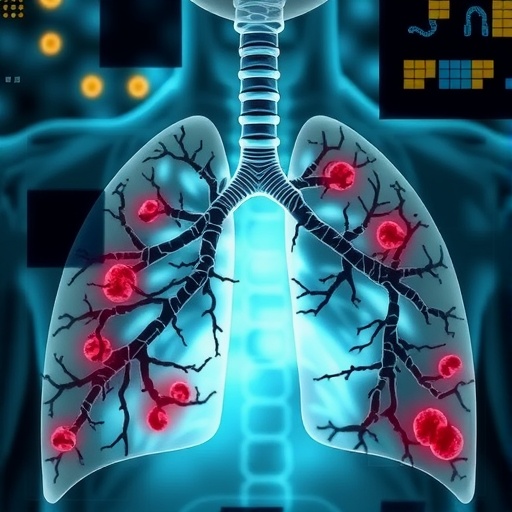In recent years, there has been burgeoning interest in understanding the complex interplay of long non-coding RNAs (LncRNAs) and insulin resistance (IR) within the context of Polycystic Ovary Syndrome (PCOS). The latest narrative review by Peng et al. sheds light on how these molecular entities evolve within the pathological framework of PCOS, painting a compelling picture of their potential role in both understanding and managing this widespread reproductive endocrine disorder. As researchers delve deeper into the molecular mechanisms underlying PCOS, LncRNAs have surfaced as critical regulators, challenging the traditional paradigms that have long dictated our understanding of this condition.
Polycystic Ovary Syndrome is largely characterized by a triad of symptoms: hyperandrogenism, ovulatory dysfunction, and polycystic ovary morphology. This syndrome affects a significant proportion of women of reproductive age, leading to a spectrum of health complications, including diabetes, cardiovascular diseases, and infertility. The association between insulin resistance and PCOS is particularly noteworthy, as it serves as a critical pathway that links metabolic dysfunction with reproductive health issues. However, the underlying molecular mechanisms remain incompletely understood, necessitating comprehensive investigations.
At the heart of these investigations lies the intriguing class of molecules known as long non-coding RNAs. Unlike their coding counterparts, LncRNAs play vital regulatory roles in gene expression and cellular processes without encoding proteins themselves. They can influence transcriptional regulation, chromatin remodeling, and even interact with various signaling pathways, all of which contribute to the pathophysiology of several diseases, including PCOS. The unique capabilities of LncRNAs to act as molecular sponges for microRNAs and to recruit chromatin-modifying complexes highlight their profound potential in modulating insulin sensitivity and ovarian function.
One of the key findings presented in the review emphasizes the dysregulation of specific LncRNAs in women with PCOS. Elevated levels of certain LncRNAs have been associated with insulin resistance, suggesting a direct connection between these non-coding molecules and the metabolic aberrations witnessed in PCOS patients. These insights open new avenues for understanding how LncRNAs might serve as biomarkers for diagnosing insulin resistance in PCOS and potentially as therapeutic targets to ameliorate metabolic dysfunction.
Moreover, the review discusses the multifaceted interactions between LncRNAs, microRNAs, and protein-coding genes. A specific example highlighted is how LncRNAs can compete with microRNAs for binding sites, thereby enhancing the expression of certain target genes involved in glucose metabolism and insulin signaling pathways. This competitive endogenous RNA (ceRNA) hypothesis suggests a sophisticated regulatory network where LncRNAs act as pivotal players in modulating insulin sensitivity, making them a focal point for future research.
In addition to their regulatory roles, the review points out that LncRNAs may contribute to the inflammatory milieu characteristic of PCOS. Chronic low-grade inflammation is a hallmark of the syndrome, and it is increasingly recognized that insulin resistance is both a perpetrator and a victim of this inflammatory state. LncRNAs have been implicated in orchestrating inflammatory responses, influencing cytokine production and immune cell activation, which further complicates the metabolic landscape of PCOS. Thus, understanding the relationship between LncRNAs and inflammation could bring about novel insights into the management of PCOS through anti-inflammatory strategies.
The narrative review by Peng et al. also highlights potential therapeutic implications of targeting LncRNAs. Given their pivotal roles in cellular mechanisms, pharmacological modulation of specific LncRNAs might offer a new strategy in restoring insulin sensitivity in women suffering from PCOS. For instance, methods to inhibit overactive LncRNAs could pave the way for enhancing metabolic profiles, improving the likelihood of achieving a normal ovulatory cycle and reducing the risk of long-term complications associated with insulin resistance.
Another layer of complexity is added when considering the genetic underpinnings of LncRNA expression. The review underscores that genetic polymorphisms may influence the expression levels of certain LncRNAs, contributing to the risk profiles for developing insulin resistance in PCOS. Ethnic differences in LncRNA variations open up exciting prospects for personalized medicine, where understanding an individual’s genetic background could help tailor specific therapies to improve outcomes in PCOS management.
As the literature in this field continues to expand, the narrative presented by Peng et al. serves as a clarion call for researchers to further explore the intricate network of LncRNAs, insulin resistance, and their implications in reproductive health. Groundbreaking discoveries will likely emerge from ongoing research into the LncRNA landscape, which holds promise for redefining our approaches to diagnosing and treating PCOS.
In conclusion, the intricate dialogue between long non-coding RNAs and insulin resistance represents an evolving frontier in the study of Polycystic Ovary Syndrome. As our understanding deepens, it may alter paradigms in PCOS management while underscoring the importance of this regulatory RNA class in the pathogenesis of metabolic disorders. The unfolding narrative is not only vital for researchers but also has the potential to empower clinicians to provide more targeted and effective care for women affected by this challenging syndrome, ushering in a new era of precision medicine.
As we look to the future, the emerging landscape of LncRNA research holds the potential to bridge several gaps in our knowledge about PCOS. The relationship between insulin resistance, hormonal imbalances, and LncRNA expression patterns offers a fertile ground for innovative research initiatives that could transform our understanding of this complex condition. The implications of these findings could reverberate throughout the fields of endocrinology and gynecology, opening doors to novel therapeutic strategies and enhanced patient outcomes.
The work by Peng et al. is a crucial addition to the existing body of literature, providing a comprehensive review that not only elucidates the connections between LncRNAs and insulin resistance but also paves the way for future research endeavors. As the scientific community continues to uncover the secrets held within our genomes, the story of LncRNAs and PCOS is poised to evolve, presenting an opportunity to reimagine how we approach, diagnose, and treat conditions intricately linked to women’s health.
As evident from this discourse, there is much yet to be explored in the realm of LncRNAs and their roles in conditions like PCOS. Continued research in this area promises to enhance our understanding of the molecular basis of metabolic disorders and reproductive health, potentially leading to groundbreaking advances in therapeutic development and intervention strategies.
Subject of Research: Interaction of LncRNAs and insulin resistance in Polycystic Ovary Syndrome
Article Title: Role and interaction of LncRNAs and insulin resistance in polycystic ovary syndrome: a narrative review.
Article References: Peng, M., Zhang, X., Yang, X. et al. Role and interaction of LncRNAs and insulin resistance in polycystic ovary syndrome: a narrative review. J Ovarian Res 18, 267 (2025). https://doi.org/10.1186/s13048-025-01858-1
Image Credits: AI Generated
DOI: https://doi.org/10.1186/s13048-025-01858-1
Keywords: LncRNAs, insulin resistance, Polycystic Ovary Syndrome, metabolic dysfunction, reproductive health, chronic inflammation, personalized medicine.
Tags: emerging research on PCOS treatmentshyperandrogenism and reproductive healthinfertility challenges in PCOSinsulin resistance and women’s health issuesinsulin resistance mechanisms in PCOSLncRNAs as regulators in PCOSLncRNAs in Polycystic Ovary Syndromemetabolic dysfunction in reproductive healthmolecular pathways of insulin resistancePCOS and cardiovascular diseasesrole of long non-coding RNAs in metabolic disordersunderstanding LncRNAs in endocrine disorders





